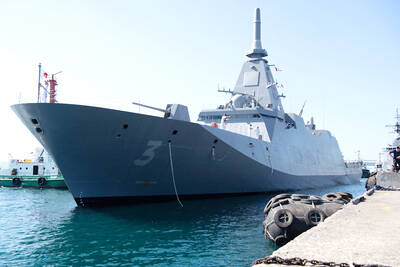Its news, features and entertainment shows are in Russian. But it is made in Beijing. China is projecting its voice across the globe with a new channel targeting 300 million viewers across the former Soviet Union — part of an expansion of foreign language state media fuelled by a reported injection of up to 45 billion yuan (US$6.6 billion).
The Russian service launched by the Chinese state broadcaster CCTV on Thursday arrived months after an Arabic channel which followed established English, French and Spanish services. Portuguese is coming soon. The Global Times newspaper has launched an English edition; its older rival, China Daily, is setting up overseas bureaus.
And the state news agency Xinhua has taken its first step into television — short news programs to be screened outside embassies and in supermarkets in Europe and on 3G phones. The logical next stage is a Chinese CNN or al-Jazeera, and some predict not one but two new international channels: a 24-hour English news service and Chinese business coverage.
“Some see this as a historic moment for making China’s voice heard in the world. You can put forward the projects you’ve always wanted to do and the government will probably wire you the money,” said one journalist working in the state media. “Others aren’t so sure it will work in the way that, say, CNN has. Western audiences are used to a different approach.”
Officials have promoted the “going out” strategy for years, but now they can afford to invest in it.
“The Olympics was a big driving force,” said Steven Dong (董關鵬), a media adviser to the central government.
Many see the Chinese anger at Western coverage of the fatal riots in Tibet last year as a key turning point.
“There is continuous bias and misunderstanding against China in the rest of the world,” Zhang Changming (張長明), the vice president of CCTV, complained as he unveiled the Russian channel, citing “biased and untrue reporting about weather and food quality problems” before the Olympics.
“One of the major goals of the expansion of international channels is to present China objectively to the world,” he said.
Advocates say the government is engaging with the outside world, providing more access for Western media, but critics see more sophisticated management of the news.
“This is the international dimension of what we’ve called Control 2.0,” said David Bandurski, of the China media project at Hong Kong University — referring to apparent greater transparency, yet tighter controls on non-state media.
Propaganda authorities hope to set the agenda by getting their version of stories out first. The Xinhua 3G service will deliver video to people’s mobiles before they switch on their televisions and see what the BBC is saying.
On some stories, in some outlets, more information will be released earlier and more discussion permitted. But key subjects or criticisms are taboo.
The top-down, heavily centralized nature of the international expansion “presents clear problems of credibility, which would seem to undermine the objective,” Bandurski said.
Dong insisted that CCTV “does criticize some levels of the government very seriously,” but said: “Chinese culture is not a debatable culture. It’s more about modesty and harmony.”

Eleven people, including a former minister, were arrested in Serbia on Friday over a train station disaster in which 16 people died. The concrete canopy of the newly renovated station in the northern city of Novi Sad collapsed on Nov. 1, 2024 in a disaster widely blamed on corruption and poor oversight. It sparked a wave of student-led protests and led to the resignation of then-Serbian prime minister Milos Vucevic and the fall of his government. The public prosecutor’s office in Novi Sad opened an investigation into the accident and deaths. In February, the public prosecutor’s office for organized crime opened another probe into

RISING RACISM: A Japanese group called on China to assure safety in the country, while the Chinese embassy in Tokyo urged action against a ‘surge in xenophobia’ A Japanese woman living in China was attacked and injured by a man in a subway station in Suzhou, China, Japanese media said, hours after two Chinese men were seriously injured in violence in Tokyo. The attacks on Thursday raised concern about xenophobic sentiment in China and Japan that have been blamed for assaults in both countries. It was the third attack involving Japanese living in China since last year. In the two previous cases in China, Chinese authorities have insisted they were isolated incidents. Japanese broadcaster NHK did not identify the woman injured in Suzhou by name, but, citing the Japanese

YELLOW SHIRTS: Many protesters were associated with pro-royalist groups that had previously supported the ouster of Paetongtarn’s father, Thaksin, in 2006 Protesters rallied on Saturday in the Thai capital to demand the resignation of court-suspended Thai Prime Minister Paetongtarn Shinawatra and in support of the armed forces following a violent border dispute with Cambodia that killed more than three dozen people and displaced more than 260,000. Gathered at Bangkok’s Victory Monument despite soaring temperatures, many sang patriotic songs and listened to speeches denouncing Paetongtarn and her father, former Thai prime minister Thaksin Shinawatra, and voiced their backing of the country’s army, which has always retained substantial power in the Southeast Asian country. Police said there were about 2,000 protesters by mid-afternoon, although

MOGAMI-CLASS FRIGATES: The deal is a ‘big step toward elevating national security cooperation with Australia, which is our special strategic partner,’ a Japanese official said Australia is to upgrade its navy with 11 Mogami-class frigates built by Japan’s Mitsubishi Heavy Industries, Australian Minister for Defence Richard Marles said yesterday. Billed as Japan’s biggest defense export deal since World War II, Australia is to pay US$6 billion over the next 10 years to acquire the fleet of stealth frigates. Australia is in the midst of a major military restructure, bolstering its navy with long-range firepower in an effort to deter China. It is striving to expand its fleet of major warships from 11 to 26 over the next decade. “This is clearly the biggest defense-industry agreement that has ever